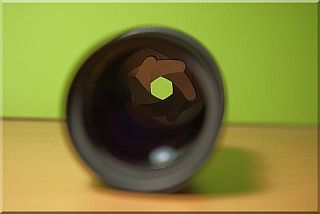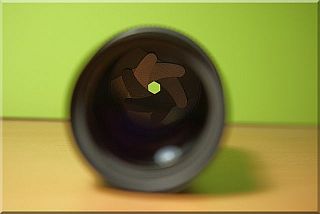As we mentioned in the last post, if we need more light, we can enlarge the hole or keep the hole open a longer time.
Enlarging the hole – also named aperture, is usually done mechanically through a set of rings with different inner diameters or with a more complex element called diaphragm placed in the optical path to limit the light admitted by the system. The diaphragm functions much like the iris of the eye that controls the diameter of the pupil. Try a very simple experiment: sitting in front of a mirror, turn the lights on and off and look at your eyes carefully. You should see the iris closing the pupil when you turn the lights on and opening the pupil when you turn the lights off.
Virtually all modern cameras use diaphragm which is usually part of the lens fixture.
In photography, these mechanical elements are called aperture stops (in the sense that a stop determines a certain brightness at an image point).
The lens aperture is usually specified as an F-number representing the ratio of focal length to effective aperture diameter. “One F-stop” refers to a factor of √2 (~1.41) change in the F-number, which corresponds to a factor of 2 change in the light intensity. As consequence, if we start from 1 as a reference (the lens has a diameter equal to the focal distance), multiplying recursively by 1.41 we find the following (rounded) numbers: 1, 1.4, 2, 2.8, 4, 5.6, 8, 11, 16, 22, 32, etc. Conventionally, these numbers use one of the following notations:
- F1, F1.4, F2, F2.8, F4, F5.6, F8, F11, F16, F22, F32 or
- f/1, f/1.4, f/2, f/2.8, f/4, f/5.6, f/8, f/11, f/16, f/22, f/32
to remind us that they refer to the focal length.
Example: a lens with a focal distance of 50 mm has a maximum aperture of F4; the diameter of the lens is 12.5 mm. Please note the SI units used in this example. Virtually all the measurements used in photography are expressed in SI units (and not imperial units).
When we search for cameras and lenses one parameter that comes into our attention is the aperture range (or the minimum and maximum aperture). The maximum aperture (also called the “lens speed”) is the largest opening and the minimum aperture is the smallest opening.
As we showed above, the larger the aperture the more light can get onto the sensor: this is desired in many cases because it allows photography in low light. If the maximum aperture is larger than f/2.8 the lens is said to be fast lens. However, despite the above mentioned advantage, fast lenses are large, heavy and expensive; they also provide a shallow depth of field (as we will discuss in another post).
While the maximum aperture depends on the focal length and lens design, the minimum aperture is chosen based on practicality – we will see that small apertures reduce the sharpness of the image because of diffraction.
We will return to aperture in a later post when we will insist more on the creative side of using different F-stops and lenses with different maximum apertures and their value for the photographer.



